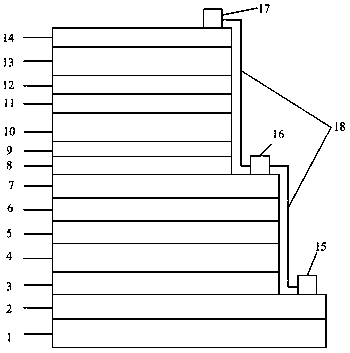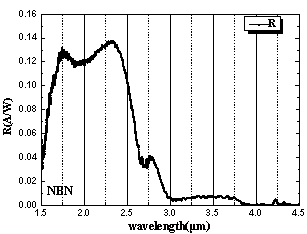A preparation method of a short-wave/medium-wave/long-wave three-band infrared detector
An infrared detector, three-band technology, applied in the direction of semiconductor devices, electrical components, circuits, etc., can solve the problems of incomplete replication of pre-set layer components and target components, low utilization rate of evaporation source materials, evaporation source pollution, etc. , to achieve the effects of suppressing generation-recombination dark current and tunneling dark current, reducing detection limit and improving performance
- Summary
- Abstract
- Description
- Claims
- Application Information
AI Technical Summary
Problems solved by technology
Method used
Image
Examples
Embodiment 1
[0041] In the embodiment of the present invention, the degassed N-type GaSb (001) substrate is transferred into the growth chamber to remove the oxide layer by raising the temperature. After the substrate temperature exceeds 370 ° C, the Sb protection beam is introduced, and the size of the Sb protection beam is at 10 -6 Torr level, real-time monitoring by REED, on the basis of the temperature 600°C when the deoxidation point appears on the substrate surface, increase 30°C, that is, 630°C, and deoxidize for 25 minutes.
[0042] In the embodiment of the present invention, the n-type doped GaSb buffer layer 2 is grown on the GaSb substrate 1 with a thickness of 1.1 μm. Among them, the Te doping concentration in the GaSb buffer layer is close to 2×10 18 cm -3 .
[0043] In the embodiment of the present invention, the n-type InAs / GaSb superlattice contact layer 3 is grown on the n-type doped GaSb buffer layer 2 with a thickness of 0.5 μm. This layer is composed of alternatel...
Embodiment 2
[0058] In the embodiment of the present invention, the degassed N-type GaSb (001) substrate is transferred into the growth chamber to remove the oxide layer by raising the temperature. After the substrate temperature exceeds 370 ° C, the Sb protection beam is introduced, and the size of the Sb protection beam is at 10 -6 Torr level, real-time monitoring by REED, on the basis of the temperature 600°C when the deoxidation point appears on the substrate surface, add 30°C, that is, 630°C, and deoxidize for 20 minutes.
[0059] In the embodiment of the present invention, the n-type doped GaSb buffer layer 2 is grown on the GaSb substrate 1 with a thickness of 0.92 μm. Among them, the Te doping concentration in the GaSb buffer layer is close to 2×10 18 cm -3 .
[0060] In the embodiment of the present invention, the n-type InAs / GaSb superlattice contact layer 3 is grown on the n-type doped GaSb buffer layer 2, and its thickness is 0.53 μm. This layer is composed of alternately...
Embodiment 3
[0075] In the embodiment of the present invention, the degassed N-type GaSb (001) substrate is transferred into the growth chamber to remove the oxide layer by raising the temperature. After the substrate temperature exceeds 370 ° C, the Sb protection beam is introduced, and the size of the Sb protection beam is at 10 -6 Torr level, real-time monitoring by REED, 30°C is added to the temperature of 600°C when the deoxidation point appears on the substrate surface, that is, 630°C, and deoxidation is performed for 22 minutes.
[0076] In the embodiment of the present invention, the n-type doped GaSb buffer layer 2 is grown on the GaSb substrate 1 with a thickness of 0.88 μm. Among them, the Te doping concentration in the GaSb buffer layer is close to 2×10 18 cm -3 .
[0077] In the embodiment of the present invention, the n-type InAs / GaSb superlattice contact layer 3 is grown on the n-type doped GaSb buffer layer 2 with a thickness of 0.5 μm. This layer consists of alternat...
PUM
 Login to View More
Login to View More Abstract
Description
Claims
Application Information
 Login to View More
Login to View More - R&D
- Intellectual Property
- Life Sciences
- Materials
- Tech Scout
- Unparalleled Data Quality
- Higher Quality Content
- 60% Fewer Hallucinations
Browse by: Latest US Patents, China's latest patents, Technical Efficacy Thesaurus, Application Domain, Technology Topic, Popular Technical Reports.
© 2025 PatSnap. All rights reserved.Legal|Privacy policy|Modern Slavery Act Transparency Statement|Sitemap|About US| Contact US: help@patsnap.com



